How Remote Workers Build Systems That Travel With Them
Master remote work: 8 structured systems to skyrocket productivity, safeguard freedom, and thrive anywhere—operate, measure, and scale success independent of location.
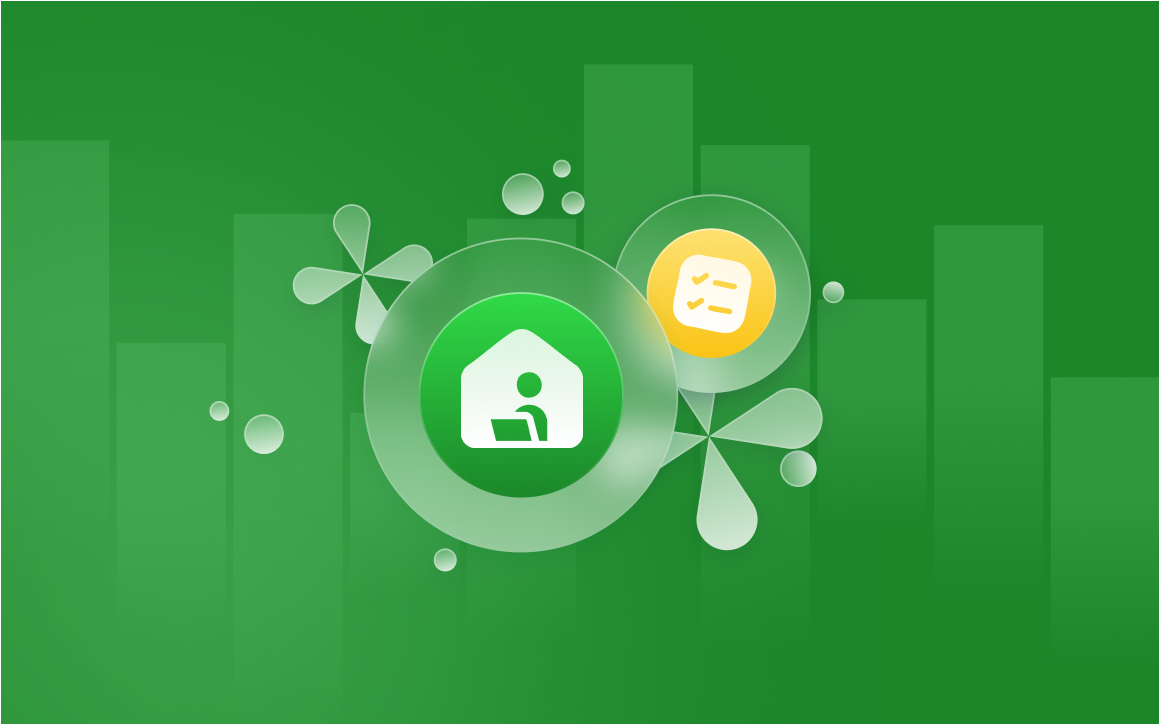
Picture this: instead of a single, humming office tower, the “workplace” is now a patchwork of kitchen tables, spare bedrooms, and coffee-shop corners stretching across every time zone.

About one in six companies have gone fully remote—no headquarters, no turnstiles, just Wi-Fi and trust—while countless others let people split their week between couch and conference room.

Worldwide Workspaces
The shift is especially common in software teams, where code ships just as smoothly from a balcony in Bali as it does from a cubicle in California.

Why the change? For employers, it’s like casting a worldwide net: they can hire the best person for the job regardless of zip code, save on sky-high rent, and often see productivity climb.
For workers, it means skipping the commute and designing a day that actually fits their life.
Still, the honeymoon isn’t universal. Some CEOs who once championed “remote forever” are now gently (or not so gently) nudging people back toward the office, only to meet a collective, “Do we have to?”
It turns out that once you’ve tasted freedom—and a 30-second commute—going back to fluorescent lights and rush-hour traffic feels a lot like swapping a home-cooked meal for cafeteria mystery meat.
Furthermore, the anywhere-anytime remote work dream can turn into a nightmare in the absence of strong systems to facilitate it.
Successful, very productive remote workers who thrive in this environment have learned to turn potential chaos into intentional, predictable success through structured approaches that operate independent of geography, time zone, or local infrastructure, using these eight top remote working tips...
The Digital Nomad's Playbook: 8 Essential Systems for Location-Independent Success
#1 - Design Your Own Operating System
The most effective remote workers don't simply adapt to new environments—rather, they create personal operating systems that function exactly the same regardless of external conditions.
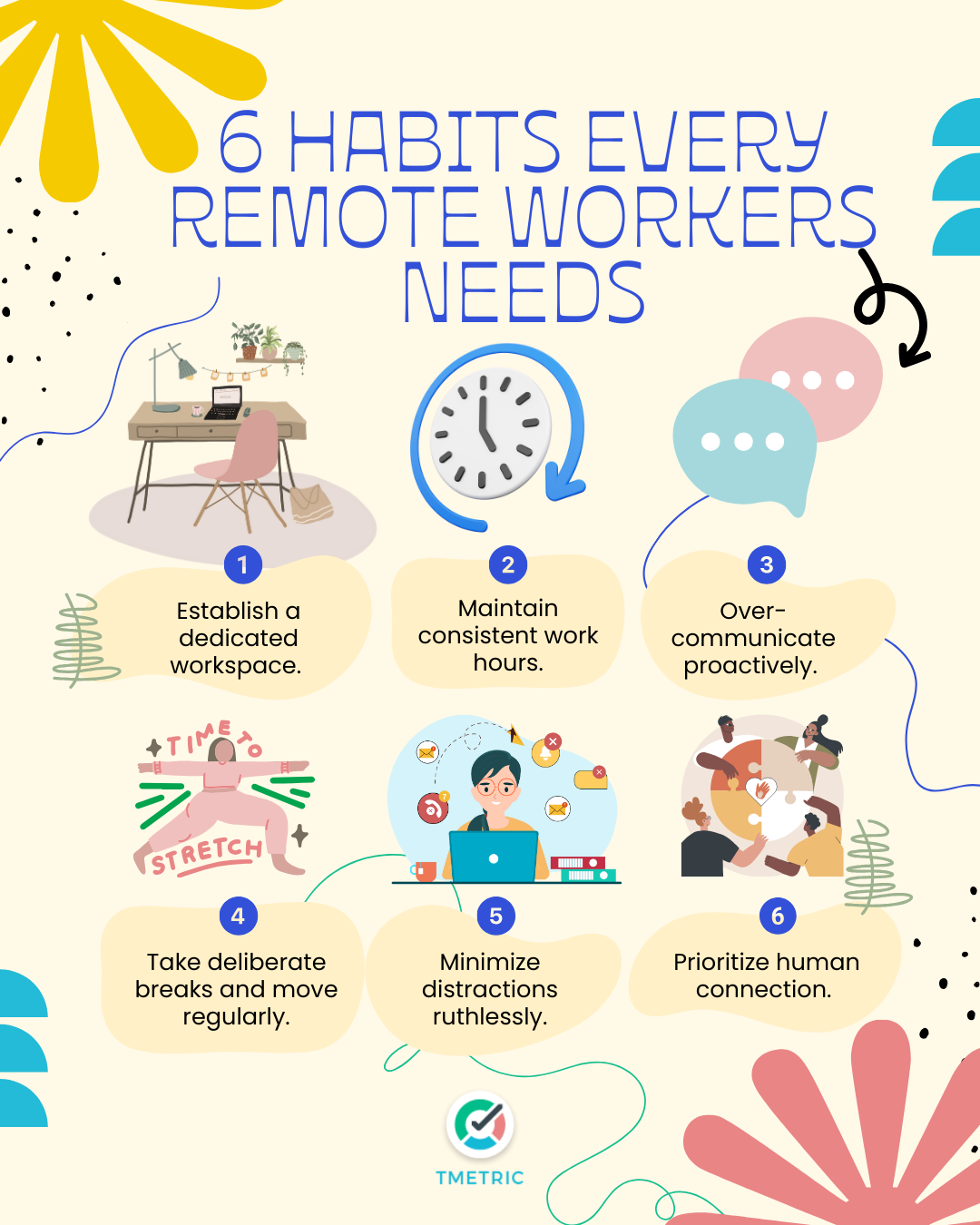
They build:
- Habitual daily routines
- Weekly planning sessions
- Monthly review cycles.
It inserts structure and consistency even when everything else is in flux.
Their personal operating systems also have set procedures for starting and ending workdays, managing energy levels, and keeping in mind professional standards despite probable environmental distractions.
Creating a personal operating system also implies decision frameworks that reduce cognitive load and decision fatigue.
This includes:
- Setting criteria for deciding where one will work during the day
- Prioritising tasks for different time zones
- Accepting or declining new opportunities based on location and logistical considerations.
💡The idea is to set workday routine choices so that mental energy can be focused on high-leverage creative and strategic work.
#2 - Creating Relationship Maintenance Systems
How to Build a Maintainable Network (The one you will NOT abandon in two weeks)
Accept the fact: The relationship between you and colleagues will drop off without consistent communication. Studies in social relations indicate that connections need constant care in order to be strong.
The tenet of maintenance:
- Touchpoints should be short and frequent as opposed to occasional heavy interactions
- Reachout beats the reactive I need something messages
- It is about consistency more than intensity
Ensure that it is sustainable:
- Put a simple reminder in your calendar once a month to communicate with 3-5 people
- Make it short but not artificial - share an article, congratulate someone, or ask a meaningful question
- Be helpful or interesting, rather than remain noticeable
- Track your outreach where you will actually follow: calendar, notes app, CRM
The lesson here is obvious: You should have a little, repeatable habit that meets your own, real schedule and fits your personality.
It can be monthly check-ins, offering a cup of coffee every other quarter, or sending some pertinent information; choose something you can stick with instead of a fancy system you might eventually drop.
It is not to play the game to time it right, but to remain truly engaged with the people whose work and ideas you admire.
#3 - Developing Risk Management Protocols
Remote work introduces new hazards never faced by workers in offices. Successful remote workers develop strong risk management practices involving everything from data security on public wifi sites to personal protection when abroad.
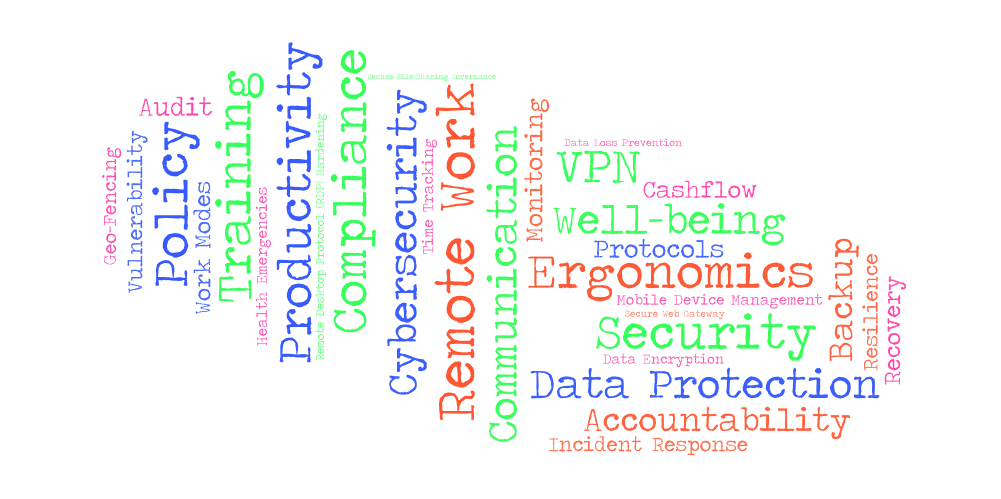
This includes:
- Building strong emergency procedures
- Possessing insurance that covers worldwide
- Establishing communication procedures with families and team members to receive frequent safety calls.
Risk management is also applied in business continuity planning.
This involves coming up with contingency plans for equipment breakdown, internet outages, political unrest, natural calamities, and health emergencies that would affect work capability.
📋The best prepared remote workers have crisis cash flow, back-up equipment, and diversified work arrangements to allow them to continue offering services even in case of a sudden interruption.

#4 - Resource Optimisation
Location independence requires becoming hyper-competent in the optimisation of limited resources like time, energy, money, and attention.
This involves:
- Designing systems of rapid decision-making on the allocation of resources across competing priorities
- Managing the additional complexity of location changes and time zones.
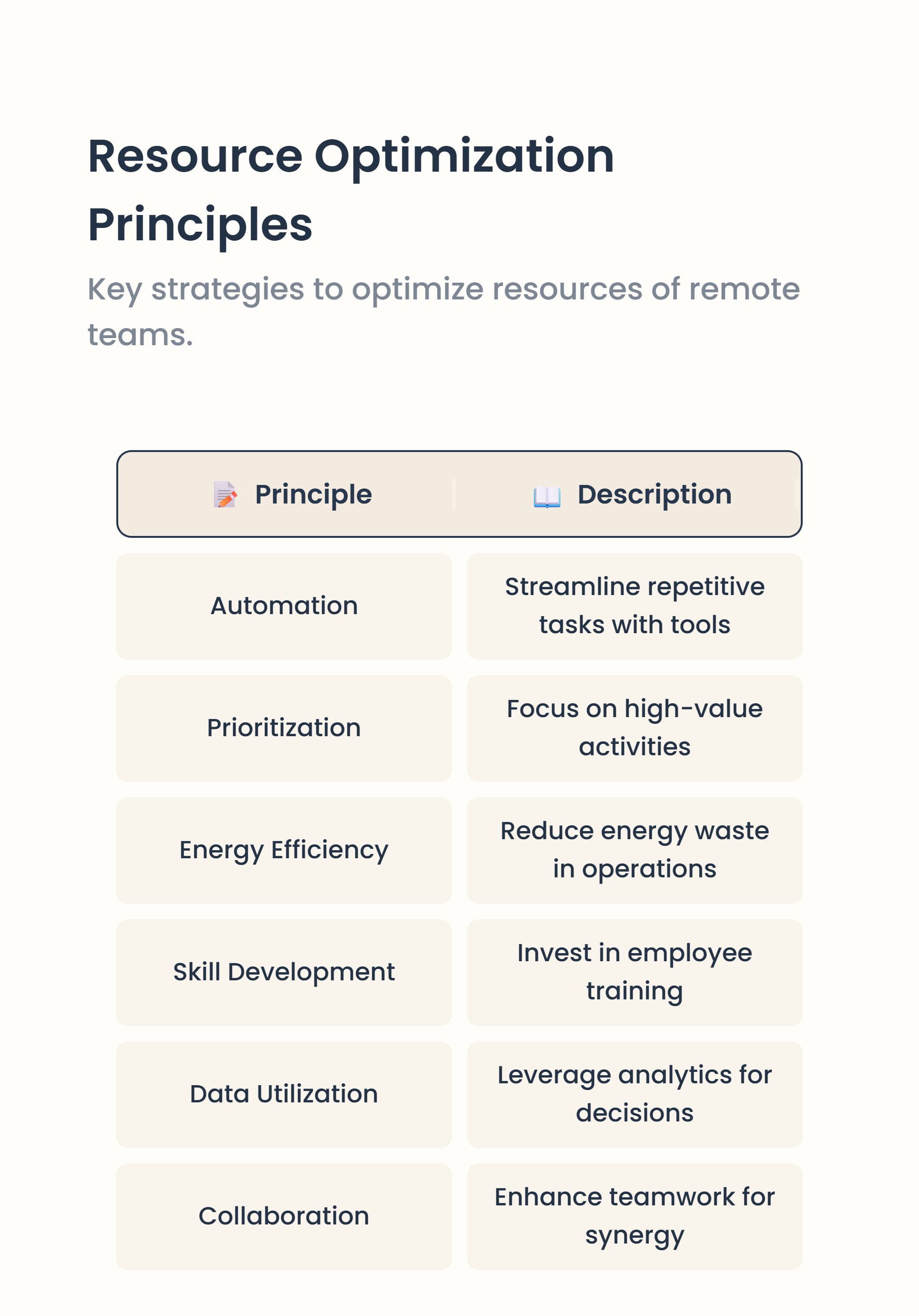
Successful remote workers develop strategic thinking when it comes to resource allocation, with the understanding that investments in one will have multiplying effects, resulting in overall efficiency gain.
Resource optimisation also entails:
- Developing capabilities in rapid research
- Adjusting to information overload
- Acquisition of new locations, services, and opportunities.
How to do it? Develop research procedures for evaluating new cities, work locations, and trusted sources of local information.
You can use a three-phase process:
- Short-list cities with macro data from government open-data portals (e.g., data.gov, Eurostat) and cost-of-living indexes (Numbeo, ERI)
- Drill down to neighborhood safety, transit, and amenities via GIS layers and crowdsourced platforms (Walk Score, Hoodmaps, Google Local Guides)
- Validate findings by triangulating recent posts on city-specific subreddits, Nextdoor feeds, and official city social-media accounts.
Rapidly identify the best sources and services in new environments (shipping, travel, and accommodation brokers).
#5 - Creating Consistency In Changing Environments
(Without Boring Yourself or Your Team to Tears)
Imagine stepping off a plane in a new city every other week and still delivering the same crisp, high-impact work your clients loved in your hometown. The secret isn’t superhuman discipline; it’s a lightweight “operating system” you can carry in your pocket and deploy anywhere.
a. Build a “Mission Control” Kit
- One cloud folder that houses every repeatable asset: proposal skeletons, slide decks, code snippets, legal clauses, even the exact font & color palette.
- A living “QC Card” (a one-page PDF) that lists the non-negotiables: tone of voice, citation style, security checklist. Keep it laminated, screenshot it, tattoo it on your subconscious—whatever prevents a last-minute scramble.
- A 5-minute “pre-flight” ritual: open the kit, run the QC Card, hit save. Done. The ritual is the consistency; the kit is just the toolbox.
b. Turn Culture into Data, Not Drama
Every new country, café, or co-working space brings invisible rules. Instead of guessing, create a micro-research loop:
- 10-minute scan: local business hours, holiday calendar, taboo topics.
- 3-question DM to a local contact you met on LinkedIn or Slack: “How blunt is too blunt in a client email here?”
- Store the answers in a running “Culture Byte” note—one paragraph per location. After six months, you’ll have a private Lonely Planet for professionalism.
c. Build a Human API
You can’t clone yourself, but you can create a plug-and-play support network:
- Airtable sheet with five columns: Name, Skill, Time Zone, Preferred Emoji, Coffee Chat Link.
- Once a month, send a 60-second Loom video update to the whole list. The investment is tiny; the payoff is a swarm of friendly experts who answer questions at 2 a.m. your time.
- Reciprocity rule: for every favor you ask, offer one 30-minute skill swap. The network stays warm and guilt-free.
d. Automate the Boring Stuff, Curate the Interesting Stuff
- Use tools like TextExpander or Raycast so typing ";addr" instantly pastes your correctly formatted business address—no matter which country’s keyboard you’re wrestling with.
- Subscribe to two industry newsletters and one “weird but useful” feed (urban planning, behavioral econ, whatever). Skim them during airport layovers; dump the best nugget into your Culture Byte file. Over time, you become the person who “always has that one perfect example.”
e. Run Mini-Post-Mortems
Every Friday, answer three prompts in a 90-second voice note:
- What almost broke?
- What local quirk saved me?
- One thing to add to the QC Card.
Transcribe with Otter.ai, tag it, forget it. Six months later, you’ll have a searchable archive of real-world hacks that no consultant could sell you.
End result: You move through time zones, languages, and Wi-Fi qualities the way a chef moves between kitchens—same recipe, same taste, zero drama. Your team feels continuity; you feel freedom.
#6 - Establishing Legal and Financial Compliance Systems
Global remote working involves complex legal and regulatory compliance issues that have to be managed in an organised fashion.
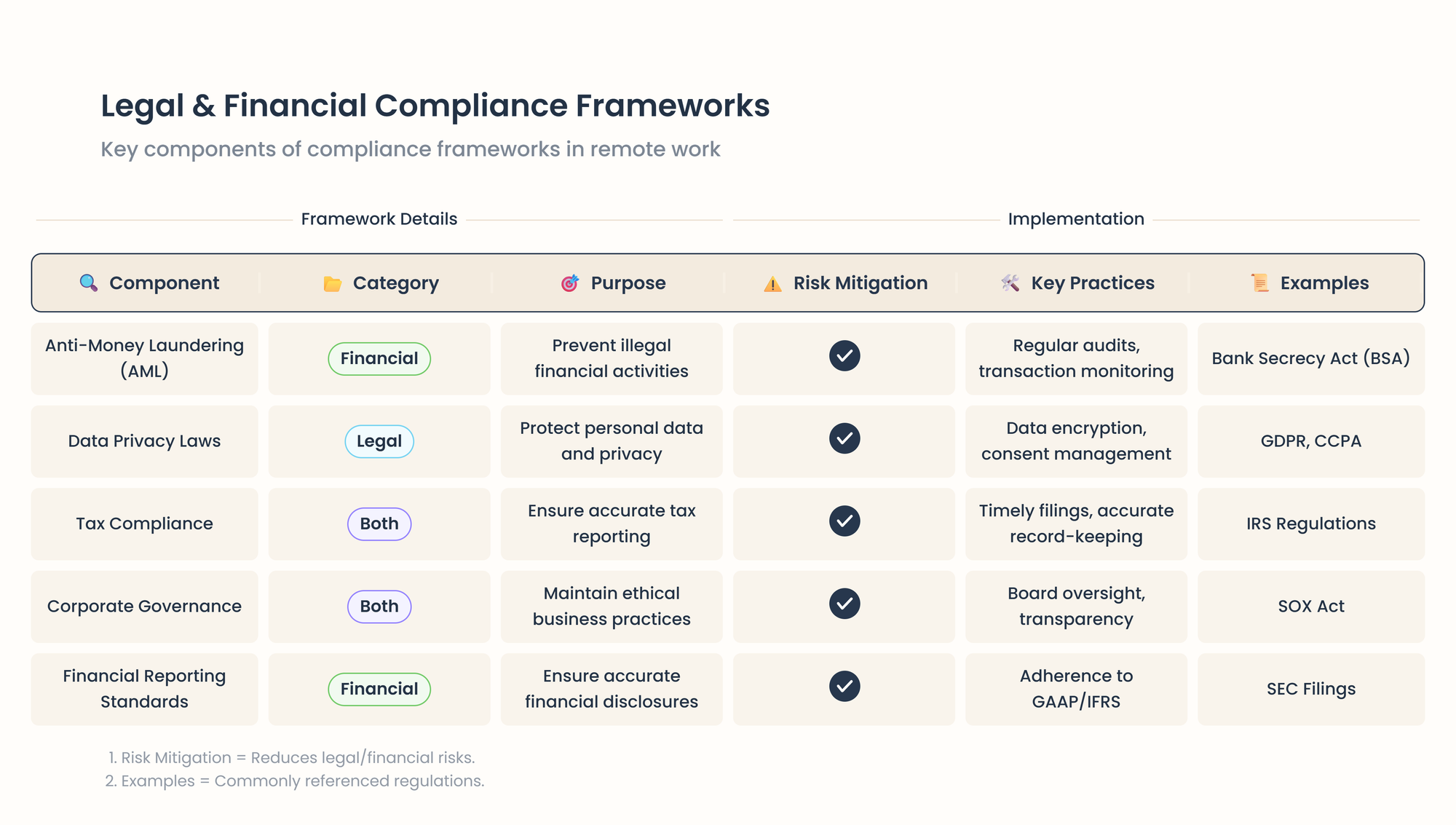
Successful remote employees have comprehensive insights into visa regulations, tax laws, and business registration legislation of their chosen locations.
That includes engaging foreign tax and law professionals in developing compliant business documents and keeping proper records of addresses, revenues, and business operations.

These frameworks also involve staying vigilant to changing regulations and legislation on remote work in other countries.
This would involve:
- Taking up subscriptions to legal newsletters
- Having access to advisers
- Belonging to professional networks that offer insight into regulatory change affecting location-independent workers.
#7 - Designing Productivity Measurement Systems
Traditional measures of productivity do not apply to location-independent work, and new systems of measurement will need to be created that are grounded in the unique requirements and possibilities of remote work.
This involves creating systems based on time tracking because they help evaluate quantitative performance.
Productive measurement entails putting in place mechanisms for tracking and comparing the impact of different locations, work environments, and daily routines on work quality and productivity.
This evidence-based methodology allows telecommuters to optimise their location strategies and work practices based on fact, rather than assumption or personal preference.
Also, consider qualitative aspects such as client satisfaction, cross-cultural learning, and personal development that are crucial to long-term success.
#8 - Implementing Scalability Planning
The remote workers who last the longest are the ones who treat growth like a game of Tetris, not Jenga: instead of stacking bricks until the tower wobbles, they pre-build the empty spaces that let new pieces slide in without toppling everything else.
Start by turning your one-person show into a plug-and-play system.
Document every repeatable task in a living playbook—how you onboard a client, how you invoice, how you hand off files—then park those playbooks in a cloud folder your future self (or your future contractor in Manila) can open at 3 a.m. local time.
The moment demand spikes, you’re not frantically re-typing instructions; you’re cloning the playbook and handing it off.
Next, diversify like a streaming service, not a buffet. Pick two or three adjacent skills your current clients already ask for and package them as “season two” of your brand. A freelance copywriter can bolt on landing-page audits; a UX designer can upsell micro-copy sprints.
Each new offer should use 70 % of the same tools and workflows you already own, so you’re expanding revenue without multiplying overhead.
Staffing up while staying borderless means building a bench before you need it. Keep a private Trello board of vetted specialists you’ve already test-driven on small tasks—your “talent pantry.”
When a big contract lands, you’re assembling a pop-up team in Slack channels, not scrambling on Upwork at midnight.
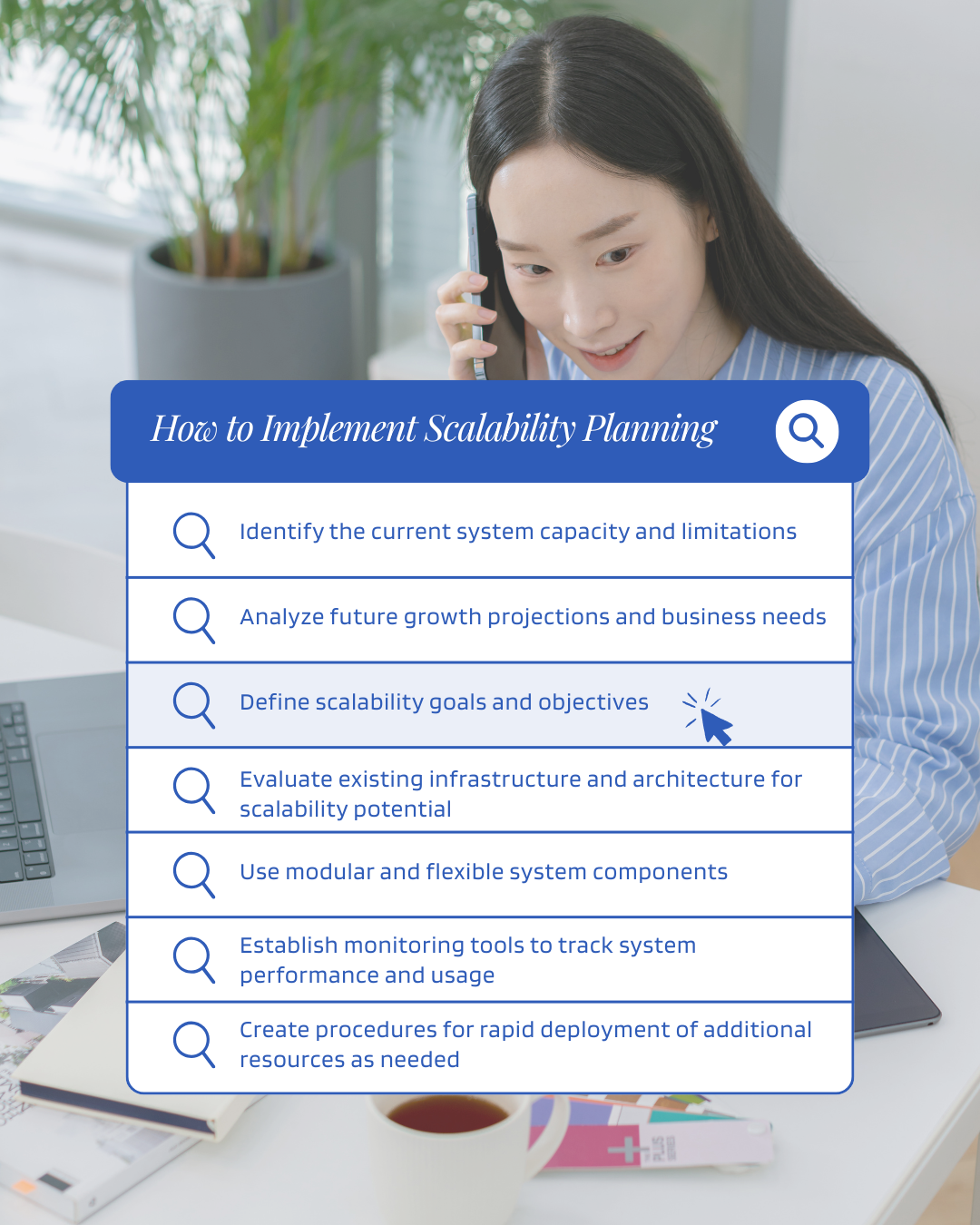
Expanding without a clear way out only trades one cage for another—shiny, maybe, but still locked.
The smartest nomads run quarterly “reverse roadmaps”: they look three years ahead and ask, “If Bali suddenly bans laptops on beaches, where would the business resettle in 30 days?”
They keep a living matrix of three possible futures—return to HQ, double-down on nomadism, or pivot to a hybrid studio model—and update it whenever tax laws, family plans, or pandemics shift the terrain.
Freedom, after all, isn’t the absence of systems; it’s the presence of better ones—lightweight, modular, and stamped with a universal serial bus so they can plug into any airport Wi-Fi, coworking loft, or (if nostalgia strikes) downtown cubicle farm.
When your infrastructure is that portable, growth stops feeling like gravity and starts feeling like lift.






